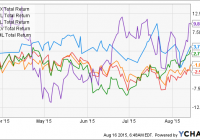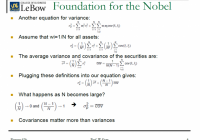There Is Nothing Total About Total Return
Summary There are several methods for calculating total return, and the results of the different calculations can vary greatly. Total return is an important concept, and for many an indicator of how wisely they invest. Funds, advisors and even individual investors use total return to compare success and profit. Do you as an individual investor know what lies behind the total return concept, and does the number you get actually provide something meaningful to you? We all like to keep a score, and as investors total return is the score to talk about and show off. Unless you are an income-oriented investor, and actually are disciplined enough to only focus on income, your portfolio’s total return will fuel your hubris or smack you down all depending on Mr. Market. So considering the apparent importance of this number we should be talking about the same thing and measure the outcomes that really matter to us. But do we really do that? What is it that you measure when you calculate total return for your portfolio, and can you use the numbers the investment advisors and brokers give you? (click to enlarge) Total return is something I have found a bit difficult to wrap my head around. It is especially hard to calculate total return for a portfolio with cash flowing in and out. I have studied the different total return calculations to try to spot the differences, and decide which one I would use myself. In this article I will sum up my findings, and I hope to initiate a discussion to cast further light on this topic. I’m going to show how total return can be completely different values depending on what you want to measure and how you calculate it. And the “what do you want to measure” part is important – do you want to know how much your portfolio actually grew over a period, or how it performed versus other investment strategies? If you do not have an idea of what and how to measure total return you can end up with numbers that are totally irrelevant , as I have argued before. I will try to show the practical implications of the different calculations using examples. Hopefully that will make it easier to understand why different calculations give different answers. For the examples in this article I will use the daily closing prices from 2015 for Apple Inc. (NASDAQ: AAPL ). There has been quite a bit of volatility in this stock in 2015, so it will serve well as an example of how sequence of returns and cash flow influences total return calculations. Data is downloaded from Yahoo Finance. The simplest form of return: Dollar return Investors are building portfolios to make money grow into more money. Since more money is the ultimate goal, why could we not just measure the return as how much the portfolio value increased? If you started the year with $10,000 and ended with $12,000, with no contributions or withdrawals, the value of your portfolio would have increased with $2,000. You are in fact $2,000 richer at the end of the year. Even accounting for the cash flow is quite simple – just subtract from the year-end value any contributions and add any withdrawals. You will have full control of the increase or decrease in portfolio value. So why are we not happy with just looking at dollar returns? The main issue is that dollar returns cannot be compared across portfolios, and we want to be able to compare our performance against other portfolios. For many individual investors it’s a matter of comparing the performance of a financial advisor or portfolio manager against other providers of these services. To be able to compare we calculate the return as a percentage of portfolio value. In the example mentioned above the percentage return would be 20%. When you have no cash flow this simple calculation will provide your portfolio’s total return. But when we add cash flow to the portfolio the calculation becomes a bit more complex, and you actually have to make a choice regarding the calculation method. How cash flow is handled is actually the only thing separating the different approaches to calculating total return. Single purchase vs. dollar cost averaging Total return for a single purchase of stock is not very complicated. You take the sell price, subtract the buy price, add any dividend received, and divide that total by the buy price. There is no cash flow to complicate the calculations, and you don’t have to worry about reinvesting dividends. If you had bought shares of Apple on January 2nd and held them until October 30th you would have made a nice profit. P 0 = 109.33 (close price on January 2nd 2015) P 1 = 119.50 (close price on October 30th 2015) D = $0.47 + $0.52 + $0.52 = $1.51 Total stock return = ($119.50 – $109.33 + $1.51) / $109.33 = 10.68% This is the return without reinvesting dividends. We can complicate the calculation and reinvest dividends, but still have no other cash flow. Here is the result from a great dividend reinvestment calculator you can find at dividendchannel.com. For this short period (and modest dividend) reinvestment of dividends did not have any effect on the total return. But if you calculate over a longer period it will make a difference if you choose to reinvest dividends or not. We can do another calculation going back to 2012 when Apple started to pay dividends. In this example the total return from Apple increased from 113.27% to 117.52% when dividends were reinvested. We still have only one contribution of cash and a single stock portfolio, but already we have two different numbers for total return. The concept of total return gets more complicated when we start to look at a portfolio that receives monthly contributions, reinvests dividends and where money is withdrawn from the account occasionally. The cash flow will influence the total return calculation, and the sequence of contributions, withdrawals and dividend reinvestment will have significant effect on return calculations along with the stock’s sequence of return. There are two main approaches to this. The first is to ignore the cash flows and sequence of returns – this is called a time-weighted return. The other main approach is to account for both the cash flow, adjusted by the time the cash is at work in the portfolio and the sequence of returns. This is called a value-weighted return. So which one should you use? And which is it that you get from your broker? The short answer is that it depends on what you want to do with your total return. Do you want to compare it to an index or to other investors? Then a time-weighted return is the number you want, and this also is usually the total return you will get from your financial advisor or broker. But not all brokers think this is the best approach. Here’s a screen shot from Motif.com regarding return calculation. (click to enlarge) If you want your total return to more realistically represent the actual performance, in terms of loss or gain of your portfolio, you would have to use a value-weighted return. To show this I will use a portfolio investing $1,000 in Apple stock every month in 2015. As we previously saw, Apple is up over 10% for the year. Below is a table showing the portfolio value for each month of 2015. Date Period Portfolio cash flow Value 01/30/15 $1,000.00 $1,071.62 02/27/15 $1,000.00 $2,184.22 03/31/15 $1,000.00 $3,111.54 04/30/15 $1,000.00 $4,116.69 05/29/15 $1,000.00 $5,314.46 06/30/15 $1,000.00 $6,104.88 07/31/15 $1,000.00 $6,860.34 08/31/15 $1,000.00 $7,368.10 09/30/15 $1,000.00 $8,155.92 10/30/15 $1,000.00 $9,904.50 A total of $10,000 was invested in the portfolio, but the portfolio value was only 9,904.50 at the end of October. The dollar return was -$95.50 for the portfolio despite the 10% appreciation of Apple in 2015. The reason for this is the sequence of returns. The table above shows how the price of Apple soared during the first five months of 2015, and then fell back during the next four months, before the final rally in October. For the portfolio this was most unfortunate. During the “good” months in the beginning of the year the shares from only a few months of contributions benefited from the rise in stock price. For the next few months, new shares were bought at peak prices before the stock tumbled. More shares were bought at a lower cost over the next few months, but even with those fortunate purchases and the October rally the portfolio ended up with a minor loss. Rearranging the sequence of the monthly returns will provide a different return. Many factors clearly have an effect on the return of a portfolio. And the gain or loss of a portfolio is the definitive measure of success or failure as an investor. I have calculated the total return of this portfolio using different approaches to total return to see how well they reflect the experienced success/failure for the investor. Apple stock return 10.68% Portfolio dollar return -$95.50 Simple return on invested capital -0.96% Time-weighted return (monthly periods) 9.07% True time-weighted return 10.64% Value-weighted return (Internal rate of return) 1.85% Value-weighted return (Modified Dietz) 1.87% A bit confusing isn’t it? But it seems quite clear that the value-weighted returns better represent the actual gain/loss of the portfolio than the time-weighted returns. The two different value-weighted returns results from two different methods of calculation. The results in this case were quite similar, but the discrepancies can be significant. Given the finding that the value-weighted return better reflects the actual return of the portfolio, why is the time-weighted return so popular? Imagine you are a financial advisor who told a client to buy Apple in January. The value of Apple appreciated 10% until the end of October, so it was quite good advice. But due to the client’s monthly purchases the portfolio actually ended up losing money. As a financial advisor you might find it a bit unfair if you were compared to other financial advisors based on that loss rather than on the 10% potential gain from the advice. That is the reason for why time-weighted return is the industry standard it allows for comparison based on the advisor’s performance without the client’s influence on the result through cash flow. But as you see from the different time-weighted returns in the table above, there are some traps in the time-weighted return calculation you have to be aware of. The only thing separating the two time-weighted returns above is the choice of sub-periods, but that resulted in a notable difference. Conclusion As an individual investor you might not have a financial advisor. You make your own decisions based on your own research. You are your own financial advisor. You will have to decide yourself what kind of total return you want to calculate for your portfolio. One thing is certain – there is nothing total about total return! Here are some factors that will influence how you calculate total return and the resulting number: Single stock or portfolio? Single purchase or several purchases? Cash flow and purchase dates Time-weighted return or value-weighted return? For time-weighted return: Choice of sub-periods For value-weighted return: Choice of calculation method I will follow up on this article with a few articles that takes a closer look at the different types of total return, how you calculate them and the potential mistakes you can make. Thank you for reading, and please do comment and ask questions! Remember I am just another individual hobby investor. I appreciate all forms of feed-back so I can widen my horizons and learn more about investing!

